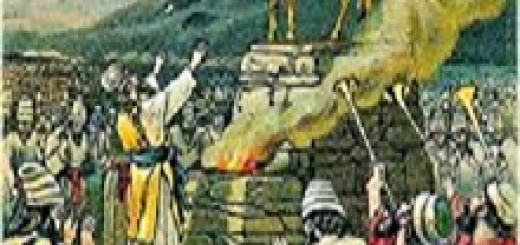By Rabbi David Sterne
We honor and respect our Jewish forefathers (Abraham, Isaac, and Jacob) for a number of reasons. The main one, of course, is that they figured out the Torah even before it was given to the Jewish people. With their lofty souls and incredible intellects, they were able to figure out what God wanted from the Jewish people even before God communicated it to the Jews. Along with that elevated spiritual status though, came some heavy responsibility. Abraham, for example, had to make some tough decisions that affected the course of Jewish history for several generations after his passing. During the “covenant of the pieces,” God faced Abraham with a choice: either the Jews would go into exile, o they would have to expiate for the sins of previous generations (Adam) in some other manner. It was Abraham who chose exile, and from then on it was determined that the Jews would have to leave Israel and descend to Egypt for a few hundred years.
Fast forward a few hundred years later to the generation of Moses, who was about to enter the Land of Israel with the Jews. That’s where we stand during this week’s parsha, Matos. The Jews had already undertaken forty-two journeys in the desert in order to arrive to the Holy Land. Our sixteenth century sage, the Megaleh Amukot (R’ Nosson Nata Shapira) tells us that the forty-two journeys also characterize the entire sweep of Jewish history. The importance of the time that the Jews spent in the desert cannot be underestimated. The Midrash (Pesikta on Mishlei 21) points out that although the Jews spent over two hundred years in Egypt, only three cities are mentioned; Pitom, Ramses and Goshen. In contrast, although the Jews spent only forty years in the desert, the Torah names forty-two encampments that they made as they travelled. This should not be surprising, since the Jews were in a state of slavery much of their time in Egypt, while in the desert they journeyed under the protection of God, with the Torah, the tabernacle, the miraculous clouds and Miriam’s well which provided them with water. So, it should have been obvious that the desert was a more meaningful experience than their sojourn in Egypt. That being the case, asks R’ Shapira, why does the Midrash go out of its way to emphasize the benefit of the journeys in the desert over the sojourn in Egypt?
Rabbi Shapiro’s answer is instructive. He tells us that the descent to Egypt was comparable to the soul leaving the body. At that point, the normal procedure is for the soul to undergo a “cleansing and purifying” process which, while painful, prepares the soul to enter the World to Come, where it “basks in the rays of the shechina, or God’s presence.” In fact, the name of the area where the Jews dwelt in Egypt – Goshen – is an acrostic for gilgulim shel neshamot (“transmigration of souls”), or neshamot shel garim (“souls of converts”). Both were true – among the Egyptians there were many who were originally Jewish souls who were lost as a result of the Adam’s primordial sin and found themselves in the “armpit of the world” – in Egypt. And when the Jews descended with Joseph and with Jacob and the tribes to live in Egypt, they provided the impetus for these lost souls to rejoin the Jewish people as “converts.”
The purification process continued as the Jews journeyed in the desert. Just as the “lost souls” could not ascend to the “World to Come” without first going through the purification and conversion process in Egypt, so the Jews could not enter the Land of Israel without first undergoing the forty-two journeys of the desert. The forty two journeys represent elevation and ascent, and there are forty-two spiritual gates above that penetrate the heavens and that is why we recite the Name of 42 (the prayer of R’ Nehunya ben Hakana) during our prayers. “Forty-two” represents the concept of ascent and elevation. The forty-two journeys also hinted at the future exiles that the Jews would have to endure. Regarding the verse (Num 33:1), “These are the journeys of the children of Israel,” the Hebrew text reads, Eileh masei bnai Yisrael. The first letters are aleph-mem-beit-yud, which form an acrostic for the four exiles: Edom (Rome) – Maday (Persia) – Babel (Babylonia) – Yavan (Greece). In this verse, the acrostic hints at the exiles in reverse chronological order, from the last exile to the first. However, when Jacob our forefather returned to Israel from the house of his father in law (Lavan), the Torah (Gen 31) tells us, “And angels of God encountered him…” In Hebrew, the words are Vayifgeu bo malachei Elokim, wherein the operative initial letters are yud (Yavan)-beit (Bavel)-mem (Maday)-aleph (Edom), naming all of the exiles in chronological order. Similarly (Gen 37), Jacob be’eretz megurei aviv, or “Jacob [dwelt] in the land of his forefathers,” also contains the four letters of the four exiles, in chronological order.
R’ Shapiro further fleshes out his thesis (that the forty-two journeys in the desert represent all of the sojourns of the Jews throughout their history) with the following explanation. From the Egyptian exodus until the death of Aaron forty years later, there were thirty-three journeys, followed by another eight journeys that took place after the passing of Aaron . Similarly, there were thirty-three generations from Abraham Avinu until the destruction of the first Temple (fourteen generations from Abraham until King David, followed by another nineteen generations until the final hurban, or “destruction”). R’ Shapira points out that the death of a tzaddik, which in the case of Aaron occurred on the first day of the Av, is comparable to the destruction of the Temple. And therefore, the thirty-three generations from Abraham concluded exactly as they did in the desert with the death of Aaron – on the first of the month of Av. Thereafter, there were another eight days, corresponding to the eight journeys of the Jews that followed Aaron ‘s death. They culminated on the ninth of Av, which of course is the day on which the Temple was destroyed. R’ Shapira points out that the final journey of the eight was called simply Yarden (Jordan), because from there, din (“strict judgment”) yarad (“descended”) to the Jewish people, and lasted until the final, forty second encampment, called aivel hashitim (the “mourning of Shitim” because the Jews went into a period of mourning until this encampment). In this manner, R’ Shapira traces out an exact correspondence between the journeys in the desert and Jewish history until the destruction of the temple.
However, we are left with an obvious question: We have only counted forty-one journeys and forty-one generations (from Abraham Avinu when the Jews were first told they would have to go into “exile”). We counted the thirty-three generations from Abraham until the first of Av, followed by the eight days leading to tisha b’Av and the destruction of the Temple. Yet, we know that there were forty-two journeys in the desert. As a matter of fact, R’ Shapira raises this question when discussing the Pesikta mentioned above. The Pesikta mentions only ma’avrot haYarden (“where we crossed the Jordan”), without mentioning a specific location, and R’ Shapira asks, “If the purpose was to mention the names of the journeys, it should have mentioned Aivel HaShitim, which was the final encampment.” But the answer is simple: Since his purpose is to demonstrate that the Pesikta carries a message – that the forty-two journeys continue until the very end of Jewish history when the Moshiach (Jewish messiah) arrives – therefore we have not arrived at the final encampment. That is why the Pesikta does not mention it by name, since it alludes to the forty two journeys that the Jews will be taking until the end of time. And that is the reason that R’ Shapira also counted only forty-one generations, and not forty-two. The point is that we are now in the midst of the forty-second journey, which will not conclude until the Moshiach arrives. The forty-second journey extends from the destruction of the Temple until the Moshiach arrives, and therefore R’ Shapira mentioned only the forty-one generations from Abraham Avinu until the destruction of the Temple.
Rabbi David Sterne is a prolific author on chassidic thought and has translated many of its seminal works. He resides in Israel and is the director of Jerusalem Connection. To read more of his work and to purchase his books visit http://www.jewishspiritualbook






















